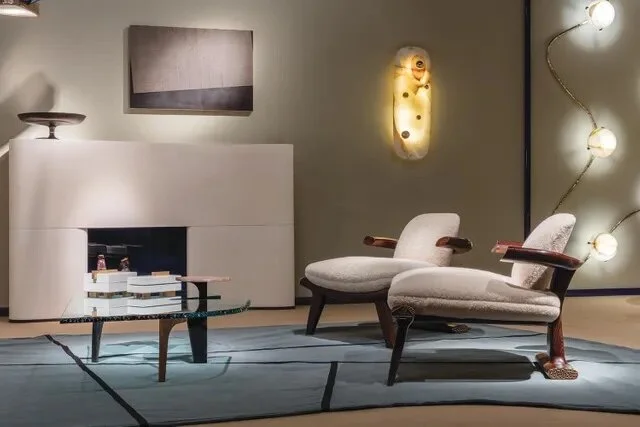Totally Tactile
Totally Tactile
Immersive Interior Design incorporates Texture
A truly inspired interior isn’t just something pretty to look at, it’s an immersive experience felt through every sense—including touch. The plushness of a shaggy rug underfoot, the splendor of running your fingers through a faux fur hide, the cozy lure of a hand-knit ottoman—by incorporating texture and tactility into your design, the look and feel becomes interactive. “Careful and thoughtful layering of a space makes a room come alive,” says Rome, Italy-based architect and designer Achille Salvagni. “Alongside color and materials, tactile elements are extremely important. These are the details that can complete a room and transform it from a clinical, sterile environment into a warm and inviting space,” he says.
Tactility can be expressed in many ways, through textured fabrics and materials, through the art of layering, whether rugs or throw blankets, or through accents and artwork that bring a sense of warmth and depth to a room. “It is important to mix the ingredients in the same way a chef creates a perfect dish, bringing all the flavors together in a harmonious balance,” Salvagni says. Contrasts between hard and soft finishes and light and dark colors are essential. And the room shouldn’t be too crowded—individual pieces need to be able to breathe and stand out on their own, Salvagni says.
Achille Salvagni, who designed the room below, says tactile elements can complete and transform a room into a warm, inviting space.
Focus on Fabrics and Finishes
The fabrics and textiles you choose are key to creating a sense of tactility. Los Angeles-based interior designer Peti Lau uses plush fabrics, such as cashmere, velvet, and mohair, to add softness to a room. “It’s the same feeling when you put on a high-quality cashmere sweater—it’s just so yummy—the same goes for designing a room with fabrics that are super soft to the touch,” she says. Cashmere can be applied as window treatments. “It drapes beautifully, is incredibly soft, and the consistency of color can be very soothing and set the tone of the room,” Lau says. Lush fabrics such as velvet, embroidery, or silk also work well for drapery.
Woven fabrics, such as mohair, are a great way to introduce textures. They lend incredibly rich color to an upholstery piece and are very durable, Lau says. She also loves to use Mongolian cashmere or a sheepskin rug in a bedroom. “It’s a fantastic way to be connected to your senses—waking up and the first thing your feet touch is that soft, plush rug,” she says. Rugs can also be layered—a faux fur hide over a natural fiber, for example. Designers Michael Violante and Paul Rochford of Violante & Rochford Interiors in Santa Fe, N.M., create a sense of touch in a room by incorporating upholstery on chairs, sofas, ottomans, and lampshades, and through artwork and antiques, wallpaper, glass and steel tables, baskets, and other woven materials like seagrass. They also love to use textiles, such as Navajo rugs, as wall hangings. Tactile finishes aren’t just limited to fabrics, upholstery, or rugs. They can also be applied to walls. Salvagni suggests using alpaca or bronze wall panels.
Nubby wallpaper, plaster-style wall treatments, upholstered pieces, textured tile or wood flooring, and light fixtures are some of the ways you can add a palpable touch to a space, says Nina Magon, founder and principal of Nina Magon Studio in Houston.
Magon first considers the use, durability, and location of the tactile piece itself. “It can be beautiful and add interest, but if it does not wear well, or doesn’t feel good, i.e., fabric that is coarse or scratchy, then it is not functional,” she says.
A bedroom by Peti Lau combines textures and colours.
Look to Layering
Layering touchable surfaces adds more interest and depth within your design. For example, using a range of different fabric throw pillows on your sofa will create beautiful layers and add interest for the eye with a range of textures, Magon says.
Salvagni chooses to layer natural textiles including sheepskin, wool, mohair, and velvet, and then adds throw pillows—all while introducing other materials like parchment, bronze, fine woods, marble, onyx, and Murano glass in the way of furniture and accessories in other areas of the room. Rugs, whether hand-tufted wool or silk, against a hardwood or stone floor for contrast, are another way Salvagni adds a tangible quality. “Each of these has a different feel and can help the ambience change during the day along with different levels of light,” he says.
Successfully layering is all about contrasting different elements, say Violante and Rochford. “You don’t want rugs to be too bulky, or accent pieces to be overwhelming; a balance between all the different textures will give you an environment that is comfortable yet stylish, with a bit of depth—and the effect of many things pulled together to create one unified feeling or experience.”
Salvagni creates harmony between textures and colours. “You can have contrast, but it must be balanced and resonate with something else in the room,” he says.
Create Balance
Balancing smooth surfaces with textured ones is key, Magon says. Color and texture are also important. “Make sure the colour and texture of your tactile surfaces blend with the other elements in your space so everything feels cohesive,” she says.
Violante and Rochford opt for soft, sheer window treatments along with stone or wood on the floor with a rug adding into the mix. “What you want is a lush, elegant tactile experience that works harmoniously,” they say.
To keep a space balanced, Salvagni uses natural materials for upholstery along with velvet and mohair. “Velvet curtains can be used to lend a sense of drama and grandeur or on the contrary, silk or sheer curtains give lightness to a room,” he says. “Colours, materials, and textures will bring all the pieces together.”
A chic yet warm room designed by Violante & Rochford Interiors.




